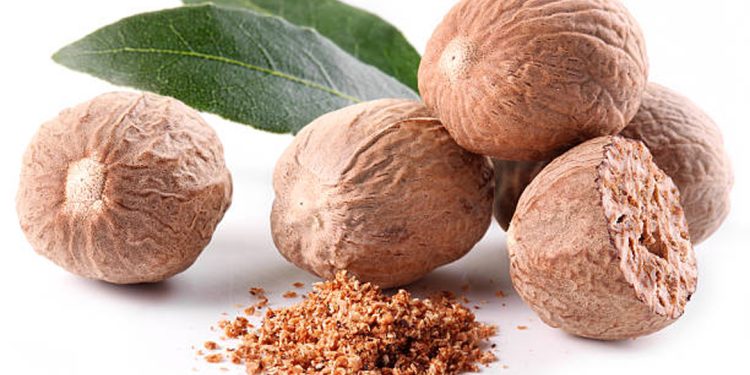An evergreen dioeciously tree, usually 9-12 m (29-39 ft.) but occasionally up to 15-20 m (49-65 ft.) tall, with glossy, pointed oval leaves and inconspicuous pale yellow flowers, male in clusters with numerous fused stamens, the female solitary or in groups. Brownish-yellow globular fruits each containing an ovoid brown seed (nutmeg), surrounded by a shredded crimson aril (mace), do not appear before the-tree is 9-10 years old.
History and traditions
Nutmeg and mace are different parts of the same fruit of the nutmeg tree. The scent of the nutmeg has variously been compared with myrrh and musk. The common name comes from “nut” and the Latin, mucus, or old French, morgue, meaning musk. Nutmegs were probably introduced to Europe in about the 6th century by Arab or Indian traders, who brought them to the Mediterranean from the Far East. The Portuguese set up a trade monopoly in this valuable spice at the beginning of the 16th century after taking possession of the Moluccas islands where the trees grew. This was taken over by the Dutch, who limited cultivation of nutmeg to the Moluccas and continued the monopoly into the 19th century. Today nutmeg is widely grown in tropical regions, with Indonesia and the West Indies as leading world producers. It has been used over the centuries as a medicinal tonic and culinary spice, its hallucinogenic properties have long been recognized and it acquired a reputation as an effective aphrodisiac.
Growth
A tender, tropical tree, grown in-sandy, humus-rich soil. Prefers shade or partial shade. Propagated by seed or cuttings. May be grown as a conservatory or hothouse plant in temperate regions, with a minimum temperature of 18°C (64°F) and a humid atmosphere.
Parts used
Seed (nutmeg), aril (mace) dried and used whole or powdered; volatile oil distilled from fruits; fatty oil compressed from mace (nutmeg butter, mace oil).
Uses
Medicinal
Nutmeg is taken internally, in small doses, for digestive disorders, nausea and insomnia. Applied externally for toothache and rheumatic aches and pains.
Culinary
Both nutmeg and mace are ground or grated and used in a wide range of sweet and savory dishes, but mace is less pungent. Added to soups, sauces, milk and cheese dishes, meat and vegetable dishes, biscuits, fruit cakes, puddings and drinks.
General
Volatile oil and fatty oil (nutmeg butter) are used in the pharmaceutical and perfumery industries.










